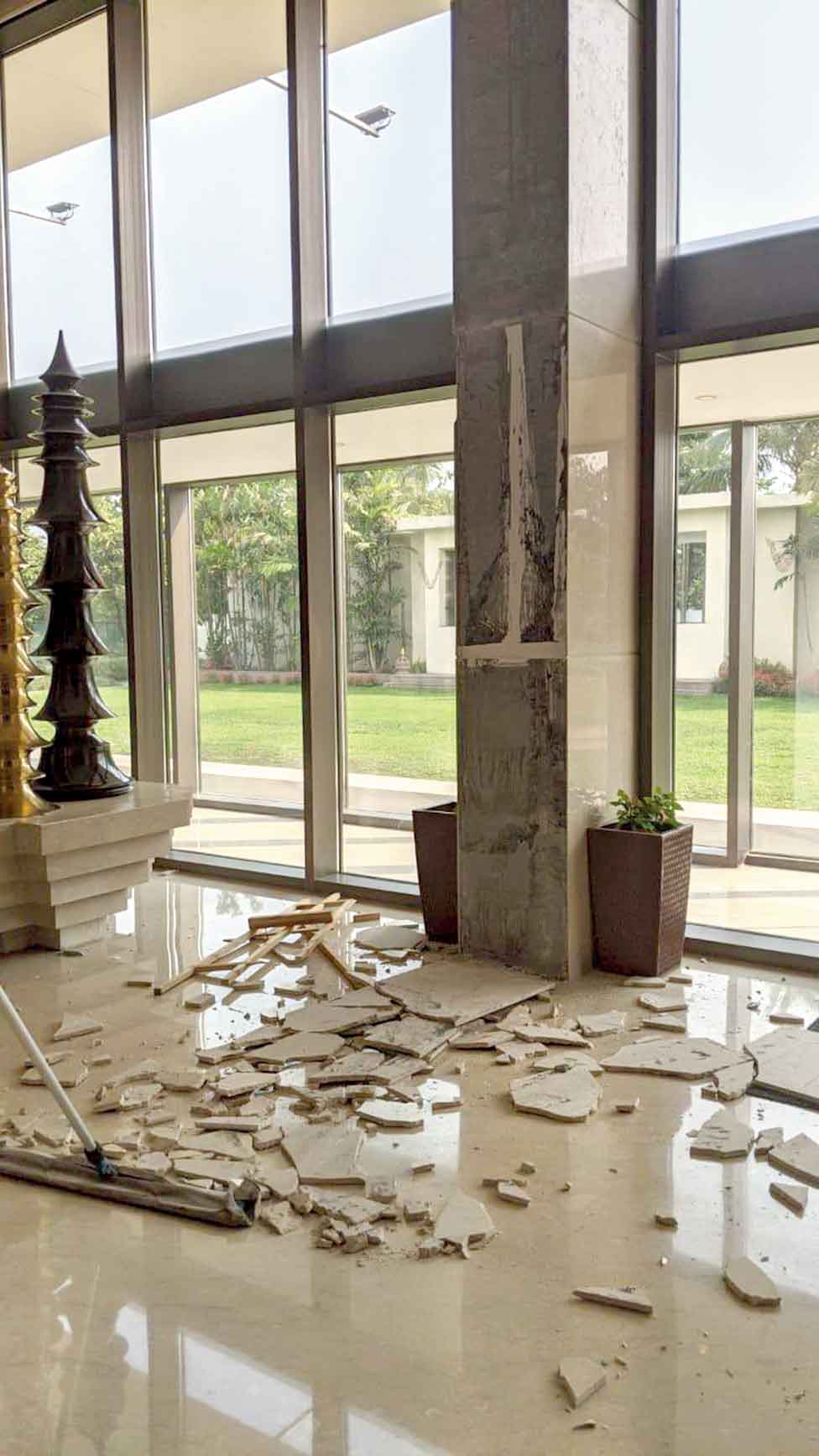An earthquake measuring 6.4 on the Richter scale rocked Assam on Wednesday morning, damaging over 200 buildings and injuring 10 people, prompting the Centre to offer assistance to the state government already grappling with the Covid-19 pandemic.
Though Assam has experienced two massive and devastating quakes on August 15, 1950, and on July 29, 1960, the tremors on Wednesday were among the most severe and scary since the seventies, according to most people The Telegraph spoke to.
The epicentre of the quake that hit the state at 7.51am was located at Dhekiajuli in Sonitpur district with a focal depth of 17km. The epicentre is closer to the plate boundary and located around 80km northeast of Guwahati; 132km north of Shillong and 180km west of Jorhat.

Broken tiles lie scattered in a building damaged in the earthquake Telegraph picture
Tremors were also felt across the Northeast and some parts of Bihar, Bengal and Bangladesh. A total of 10 aftershocks were experienced — six within two-and-a-half hours of the main shock and subsequently four more till 5.40pm.
“Preliminary analysis shows that the events are located near the Kopili fault closer to the Himalayan Frontal Thrust (HFT). The area is seismically very active falling in the highest seismic hazard zone V associated with collisional tectonics where Indian plate subducts beneath the Eurasian plate,” the National Centre for Seismology under the ministry of earth sciences said.
Damage to buildings was also reported from within 100km of the epicentre in Sonitpur, Nagaon and Guwahati, prompting the Assam State Disaster Management Authority to launch a rapid visual screening of the damage.

Sonowal examines a crack in the ground caused by the tremors in Dhekiajuli Telegraph picture
ASDMA sources said a team is assisting Assam Engineering College professor Jayanta Pathak, a structural engineer, to conduct the assessment. “We are expecting a preliminary report by Thursday,” a source said.
Preliminary reports suggest most of the 200 damaged buildings are in Guwahati followed by Nagaon and Sonitpur districts. They have mostly developed cracks. These too will be assessed for their fitness.
“Repair of two of the affected buildings in Nagaon, including the deputy commissioner’s bungalow, will be tricky,” the source said.
Two persons died due to shock/heart attack around the time the earthquake struck. Of the 10 people injured, six are from Darrang district, two from Sonitpur district while one each are from Kamrup (metro) and Nagaon districts.
On the other hand, Assam chief minister Sarbananda Sonowal directed the deputy commissioners to carry out a field survey of the damage and submit a report for detailed review and also to extend necessary help and support to the affected people.
After a visit to Dhekiajuli and adjacent areas near the epicentre to take stock of the damage, Sonowal said the earthquake had jolted Assam while it is fighting against the surge in Covid-19 cases.

A boundary wall damaged in the quake Telegraph picture
Till Tuesday, there were 19,923 active cases, most detected this month.
The quake not only shook the foundation of many buildings but also left their residents shaken as was evident from a tweet by health minister Himanta Biswa Sarma.
“The massive 6.7 tremor in Assam has left people shell-shocked but luckily no casualties reported so far. Damages to buildings, properties & roads in certain areas reported besides water gushing out of fields witnessed. No reason to panic,” Sarma tweeted.
To most residents of Guwahati, it was an experience like never before.
“I have never experienced anything like this in the past. The five-storeyed building I live in has also developed cracks. It was very scary and unnerving,” said Paresh Malakar, a Guwahati-based educationist and social activist in his sixties.
Similar sentiments were expressed by Allen Brooks, former member of the Assam State Commission for Minorities.
“I used to hear about the 1950 earthquake from my granny. The boundary wall of our home in Dibrugarh was destroyed in that quake. My grandfather had used bamboo to support the wall from collapsing. But this morning was a jolt from the blue, something the 1960s generation has not experienced before. There is an eerie feeling in the air, of death lurking all around since the outbreak of the second wave of the pandemic. Thankfully, there is no massive damage,” Brooks, also in his sixties, said in Guwahati.
The 1950 quake (8.4 on the Richter scale) not only changed the course of the Brahmaputra but also raised the river bed besides killing over 1,500 people.
Prime Minister Narendra Modi was among the central leaders to get in touch with chief minister Sonowal immediately after the tremors and assured all necessary help from the Centre.
Modi called Sonowal again in the afternoon to discuss the quake in detail. Sonowal briefed the Prime Minister about the information received from different parts of the state regarding damages caused by the earthquake.
Union ministers Amit Shah, Nirmala Sitharaman and DoNER minister Jitendra Singh also called on Sonowal and assured help.
Earthquakes have become more frequent in the Northeast, especially in Mizoram, Assam, Nagaland and Tripura. Mizoram, in fact, witnessed over 100 quakes in a span of three months since June last year.
A.C. Lyngdoh, director, Central Seismological Observatory, Shillong, urged the people to remain alert and vigilant and to adhere to the dos and don’ts issued by the administration from time to time.
The ASDMA has released three toll-free helpline numbers (1079, 1070 and 1077) for people needing assistance.










